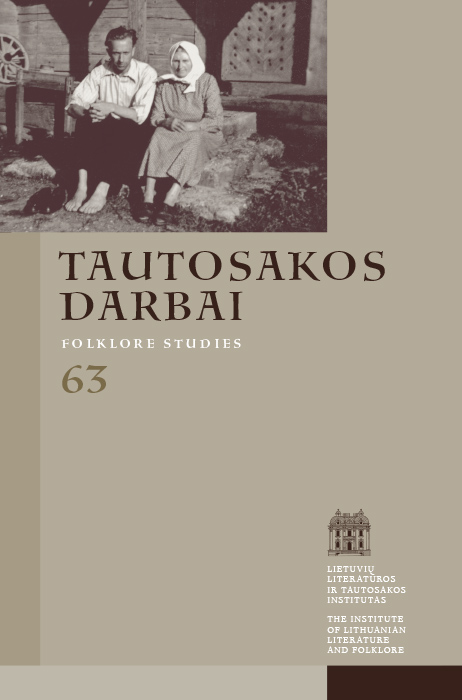Apdainavimų naratyvas ir jo istorinės atminties kontekstai
Santrauka
Tyrimo akiratyje – talaliniškų apdainavimų kuriamas naratyvas, neretai grindžiamas ypatinga, vadinamąja lotine, raiška. Aiškinantis jos ištakas į tyrimo lauką įtraukiami ir ritualinio kanono apdainavimai (ypač vestuviniai) – jų turinio savitumą ir atlikimo būdą galima sieti su tolimų laikų kultūrinės atminties reliktais. Lyginamuoju būdu stebint skirtingos paskirties (apeiginės ir pramoginės) apdainavimų lojimus išryškinamos jų turinio bei raiškos sąsajos ir atskirtys. Tokiam tyrimui atlikti palankias prielaidas teikia rusų apeiginių apdainavimų ištirtumas. Kaip integrali talalinių naratyvo dalis svarstomas marginalinių sociumo grupių – elgetų ir vyriausiųjų gyventojų – parodijavimas, įžvelgiant jame ne vien pramoginę, bet ir kur kas reikšmingesnę – kontroliuojančią – talalinių funkciją. Stebimoji talalinių apdainavimų naratyvo interpretacija atlikta remiantis XIX a. pabaigos – XX a. pirmos pusės spausdintais ir archyviniais šaltiniais.
Atsisiuntimai
Skaitomiausi šio autoriaus(ų) straipsniai
- Bronė Stundžienė, Iš sovietinės dainotyros: tarp pasirinkimo ir prievolės , Tautosakos darbai: T 65 (2023): Tautosakos darbai
- Živilė Ramoškaitė, Bronė Stundžienė, Apžvelgiant dainotyros horizontus. Bronę Stundžienę kalbina Živilė Ramoškaitė , Tautosakos darbai: T 64 (2022)
- Bronė Stundžienė, Kraštovaizdžio raišką dainose apmąstant , Tautosakos darbai: T 47 (2014)
- Bronė Stundžienė, Dainų pašaukti: knyga apie vieno folklorinio ansamblio gyvenimą , Tautosakos darbai: T 57 (2019)
- Bronė Stundžienė, Lietuvių talalinė: šiapus ir anapus leidžiamo juoko ribų , Tautosakos darbai: T 59 (2020)
- Bronė Stundžienė, Šeimos naratyvas dainose: ritualo atodangos ir kintančių kontekstų reikšmė , Tautosakos darbai: T 51 (2016)
- Bronė Stundžienė, Laiko žymės Dainyno skelbimo istorijoje , Tautosakos darbai: T 61 (2021)
- Bronė Stundžienė, Įvietinta folklorinė atmintis grožinėje kūryboje: pasvalietiškoji versija , Tautosakos darbai: T 49 (2015)
- Bronė Stundžienė, Atsigręžiant į lietuvių liaudies dainų skelbimo ištakas , Tautosakos darbai: T 56 (2018)
- Bronė Stundžienė, Rita Černiauskienė, Gimnazistiškos vieno etnologinio tyrimo patirtys iš arčiau , Tautosakos darbai: T 57 (2019)
